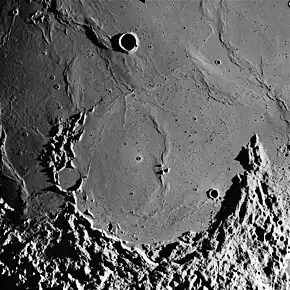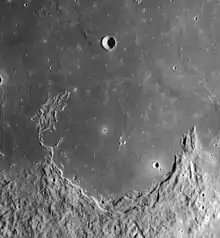Letronne (crater)
Letronne is the lava-flooded remnant of a lunar impact crater. It was named after French archaeologist Jean-Antoine Letronne.[1] The northern part of the rim is completely missing, and opens into the Oceanus Procellarum, forming a bay along the southwestern shore. The formation is located to the northwest of the large crater Gassendi.To the west-southwest is the flooded crater Billy, and north-northwest lies the smaller Flamsteed.
 Letronne from Apollo 16. NASA photo. | |
| Coordinates | 10.6°S 42.4°W |
|---|---|
| Diameter | 120 km |
| Depth | 1.0 km |
| Colongitude | 42° at sunrise |
| Eponym | Jean-Antoine Letronne |

.jpg.webp)
The surviving rim of Letronne is now little more than a semi-circular series of ridges. The flooded, broken rim of Winthrop overlies the western wall. The rim is the most intact along the eastern stretch, forming a mountainous promontory into the mare. A small cluster of central rises lie at the midpoint of the crater. The wrinkle ridge Dorsa Rubey traverses the floor from north to south,[2] and outlines a portion of the missing rim. The crater floor is otherwise nearly smooth and relatively free of craterlets, with the exception of Letronne B near the southeast rim.
Letronne is one of the largest craters of Lower (Early) Imbrian age.[3]
Satellite craters
By convention these features are identified on lunar maps by placing the letter on the side of the crater midpoint that is closest to Letronne.
| Letronne | Latitude | Longitude | Diameter |
|---|---|---|---|
| A | 12.1° S | 39.1° W | 7 km |
| B | 11.2° S | 41.2° W | 5 km |
| C | 10.7° S | 38.5° W | 4 km |
| F | 9.2° S | 46.1° W | 8 km |
| G | 12.7° S | 46.5° W | 10 km |
| H | 12.6° S | 46.0° W | 4 km |
| K | 14.5° S | 43.6° W | 5 km |
| L | 14.3° S | 44.3° W | 5 km |
| M | 12.0° S | 44.1° W | 3 km |
| N | 12.3° S | 39.8° W | 4 km |
| T | 12.5° S | 42.6° W | 3 km |
The following craters have been renamed by the IAU.
References
- "Letronne (crater)". Gazetteer of Planetary Nomenclature. USGS Astrogeology Research Program.
- Map quadrangle LAC-75, Gazetteer of Planetary Nomenclature. USGS Astrogeology Research Program
- The geologic history of the Moon. USGS Professional Paper 1348. By Don E. Wilhelms, John F. McCauley, and Newell J. Trask. U.S. Government Printing Office, Washington: 1987. Table 10.2.
- Andersson, L. E.; Whitaker, E. A. (1982). NASA Catalogue of Lunar Nomenclature. NASA RP-1097.
- Bussey, B.; Spudis, P. (2004). The Clementine Atlas of the Moon. New York: Cambridge University Press. ISBN 978-0-521-81528-4.
- Cocks, Elijah E.; Cocks, Josiah C. (1995). Who's Who on the Moon: A Biographical Dictionary of Lunar Nomenclature. Tudor Publishers. ISBN 978-0-936389-27-1.
- McDowell, Jonathan (July 15, 2007). "Lunar Nomenclature". Jonathan's Space Report. Retrieved 2007-10-24.
- Menzel, D. H.; Minnaert, M.; Levin, B.; Dollfus, A.; Bell, B. (1971). "Report on Lunar Nomenclature by the Working Group of Commission 17 of the IAU". Space Science Reviews. 12 (2): 136–186. Bibcode:1971SSRv...12..136M. doi:10.1007/BF00171763. S2CID 122125855.
- Moore, Patrick (2001). On the Moon. Sterling Publishing Co. ISBN 978-0-304-35469-6.
- Price, Fred W. (1988). The Moon Observer's Handbook. Cambridge University Press. ISBN 978-0-521-33500-3.
- Rükl, Antonín (1990). Atlas of the Moon. Kalmbach Books. ISBN 978-0-913135-17-4.
- Webb, Rev. T. W. (1962). Celestial Objects for Common Telescopes (6th revised ed.). Dover. ISBN 978-0-486-20917-3.
- Whitaker, Ewen A. (1999). Mapping and Naming the Moon. Cambridge University Press. ISBN 978-0-521-62248-6.
- Wlasuk, Peter T. (2000). Observing the Moon. Springer. ISBN 978-1-85233-193-1.